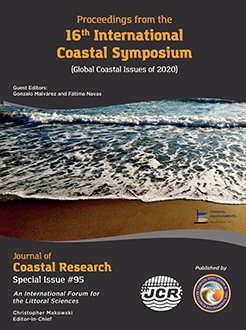Rangel-Buitrago, N., 2020. Are we managing in the right way the coastal erosion along the Caribbean coast of Colombia? In: Malvárez, G. and Navas, F. (eds.), Global Coastal Issues of 2020. Journal of Coastal Research, Special Issue No. 95, pp. 930–934. Coconut Creek (Florida), ISSN 0749-0208.
Coastal erosion has become a severe problem, rising in magnitude, dominance, and extension along the Caribbean coast of Colombia. Circa 55% of this critical area for the country is undergoing severe erosion problems related to a multiplicity of factors contrasted by their degree of influence and magnitude. The management of the coastal erosion processes has been implemented via traditional hard defense options. During the last 30 years, the necessity to protect the coast with hard structures has been driven by the growing coastal zone population and political - economic pressures. At the beginning of 2019, at least 15000 both cross and hard longshore structures have been built along the coastline. These hard structures have altered the natural conditions of the study area, producing impacts such as (i) coastal hardening, (ii) reduced sediment supplies to downdrift areas, (iii) intensification of erosion processes, (iv) generation of nearby new erosion hot spots, (v) deterioration of coastal scenery quality, among others. Direct and indirect experience indicates that optimal results, on money and a time basis, can be achieved using a combination of other coastal erosion management options, such as, “accommodation,” "planned retreat," or “do nothing” solutions delivered through legally adopted coastal management plans, coordinated by one government department is urgently required. This work describes and evaluates the functionality of current coastal erosion management strategies used up to the present. It also indicates the current and future coastal erosion management scene for the region and highlights major trends and challenges faced by users, landowners, and coastal managers.





